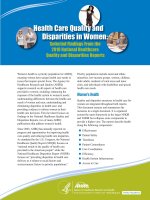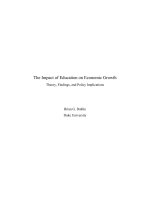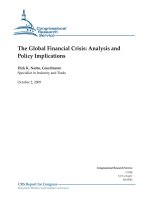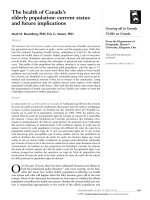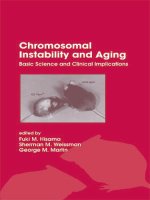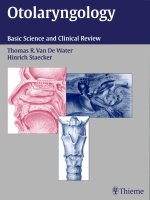THE CARDIOVASCULAR SYSTEM – PHYSIOLOGY, DIAGNOSTICS AND CLINICAL IMPLICATIONS pot
Bạn đang xem bản rút gọn của tài liệu. Xem và tải ngay bản đầy đủ của tài liệu tại đây (34.18 MB, 491 trang )
THE CARDIOVASCULAR
SYSTEM – PHYSIOLOGY,
DIAGNOSTICS AND
CLINICAL IMPLICATIONS
Edited by David C. Gaze
THE CARDIOVASCULAR
SYSTEM – PHYSIOLOGY,
DIAGNOSTICS AND
CLINICAL IMPLICATIONS
Edited by David C. Gaze
The Cardiovascular System – Physiology, Diagnostics and Clinical Implications
Edited by David C. Gaze
Published by InTech
Janeza Trdine 9, 51000 Rijeka, Croatia
Copyright © 2012 InTech
All chapters are Open Access distributed under the Creative Commons Attribution 3.0
license, which allows users to download, copy and build upon published articles even for
commercial purposes, as long as the author and publisher are properly credited, which
ensures maximum dissemination and a wider impact of our publications. After this work
has been published by InTech, authors have the right to republish it, in whole or part, in
any publication of which they are the author, and to make other personal use of the
work. Any republication, referencing or personal use of the work must explicitly identify
the original source.
As for readers, this license allows users to download, copy and build upon published
chapters even for commercial purposes, as long as the author and publisher are properly
credited, which ensures maximum dissemination and a wider impact of our publications.
Notice
Statements and opinions expressed in the chapters are these of the individual contributors
and not necessarily those of the editors or publisher. No responsibility is accepted for the
accuracy of information contained in the published chapters. The publisher assumes no
responsibility for any damage or injury to persons or property arising out of the use of any
materials, instructions, methods or ideas contained in the book.
Publishing Process Manager Iva Simcic
Technical Editor Teodora Smiljanic
Cover Designer InTech Design Team
First published April, 2012
Printed in Croatia
A free online edition of this book is available at www.intechopen.com
Additional hard copies can be obtained from
The Cardiovascular System – Physiology, Diagnostics and Clinical Implications,
Edited by David C. Gaze
p. cm.
ISBN 978-953-51-0534-3
Contents
Preface IX
Section 1 Cardiovascular Physiology 1
Chapter 1 Control of Cardiovascular System 3
Mikhail Rudenko, Olga Voronova,
Vladimir Zernov, Konstantin Mamberger,
Dmitry Makedonsky, Sergey Rudenko
and Sergey Kolmakov
Chapter 2 Molecular Control of Smooth Muscle Cell
Differentiation Marker Genes by Serum Response
Factor and Its Interacting Proteins 23
Tadashi Yoshida
Chapter 3 Trans Fatty Acids and Human Health 43
Sebastjan Filip and Rajko Vidrih
Chapter 4 Control and Coordination
of Vasomotor Tone in the Microcirculation 65
Mauricio A. Lillo, Francisco R. Pérez,
Mariela Puebla, Pablo S. Gaete
and Xavier F. Figueroa
Chapter 5 Hemodynamics 95
Ali Nasimi
Chapter 6 Adenosinergic System in the Mesenteric Vessels 111
Ana Leitão-Rocha, Joana Beatriz Sousa
and Carmen Diniz
Chapter 7 Endothelial Nitric Oxide Synthase,
Nitric Oxide and Metabolic Disturbances
in the Vascular System 135
Grażyna Lutosławska
VI Contents
Section 2 Cardiovascular Diagnostics 155
Chapter 8 The Diagnostic Performance of Cardiovascular System
and Evaluation of Hemodynamic Parameters Based
on Heart Cycle Phase Analysis 157
Mikhail Rudenko, Olga Voronova, Vladimir Zernov,
Konstantin Mamberger, Dmitry Makedonsky,
Sergey Rudenko, Yuri Fedossov, Alexander Duyzhikov,
Anatoly Orlov and Sergey Sobin
Chapter 9 Biophysical Phenomena in Blood Flow System in
the Process of Indirect Arterial Pressure Measurement 179
Mikhail Rudenko, Olga Voronova and Vladimir Zernov
Chapter 10 Interrelation Between the Changes
of Phase Functions of Cardiac Muscle Contraction
and Biochemical Processes as an Algorithm for
Identifying Local Pathologies in Cardiovascular System 195
Yury Fedosov, Stanislav Zhigalov, Mikhail Rudenko,
Vladimir Zernov and Olga Voronova
Chapter 11 Application of Computational Intelligence
Techniques for Cardiovascular Diagnostics 211
C. Nataraj, A. Jalali and P. Ghorbanian
Chapter 12 Analysis of Time Course Changes in the Cardiovascular
Response to Head-Up Tilt in Fighter Pilots 241
David G. Newman and Robin Callister
Section 3 Clinical Impact of Cardiovascular
Physiology and Pathophysiology 255
Chapter 13 Physical Activity and Cardiovascular Health 257
Raul A. Martins
Chapter 14 Cardiovascular Disease Risk Factors 279
Reza Amani and Nasrin Sharifi
Chapter 15 Cardiovascular and Cerebrovascular Problems
in the Development of Cognitive Impairment:
For Medical Professionals Involved
in the Treatment of Atherosclerosis 311
Michihiro Suwa
Chapter 16 French Paradox, Polyphenols and Cardiovascular Protection:
The Oestrogenic Receptor-α Implication 319
Tassadit Benaissa, Thierry Ragot and Angela Tesse
Contents VII
Chapter 17 Importance of Dermatology in Infective Endocarditis 345
Servy Amandine, Jones Meriem and Valeyrie-Allanore Laurence
Chapter 18 Cardiovascular Risk Factors: Implications in Diabetes,
Other Disease States and Herbal Drugs 365
Steve Ogbonnia
Chapter 19 Morphology and Functional Changes
of Intestine, Trophology Status and Systemic
Inflammation in Patients with Chronic Heart Failure 383
G.P. Arutyunov and N.A. Bylova
Chapter 20 Evaluation and Treatment
of Hypotension in Premature Infants 419
Shoichi Ezaki and Masanori Tamura
Chapter 21 Role of Echocardiography in Research into Neglected
Cardiovascular Diseases in Sub-Saharan Africa 445
Ana Olga Mocumbi
Chapter 22 Psychophysiological Cardiovascular
Functioning in Hostile Defensive Women 465
Francisco Palmero and Cristina Guerrero
Preface
The cardiovascular system includes the heart located centrally in the thorax and the
vessels of the body which carry blood. The cardiovascular (or circulatory) system
supplies oxygen from inspired air, via the lungs to the tissues around the body. It is
also responsible for the removal of the waste product, carbon dioxide via air expired
from the lungs. The cardiovascular system also transports nutrients such as
electrolytes, amino acids, enzymes, hormones which are integral to cellular
respiration, metabolism and immunity.
This book is not meant to be an all encompassing text on cardiovascular physiology
and pathology rather a selection of chapters from experts in the field who describe
recent advances in basic and clinical sciences. As such, the text is divided into three
main sections:
Cardiovascular Physiology
In this section, the control of the cardiovascular system is discussed in particular the
heaemodynamic mechanisms controlling blood volume, flow and the regulation of
systolic blood pressure. The next chapter investigates the molecular control of smooth
muscle cell (SMC) differentiation marker genes by serum response factor (SRF)
including the interaction of myocardin as a potent cofactor of SRF in SMC
differentiation. The chapter also details the interaction of GATA-6, Klf4, LIM-only
proteins CRP1 and 2 and PIAS-1 with SRF. The following chapter reports on trans
fatty acids (TFA) and human health, detailing the biochemistry of trans fats as well as
recommended daily intake. The chapter describes both animal and human studies of
TFA. There are details on the analytical determination of TFA as well as their potential
antioxidants. There is also a comprehensive overview of TFA and legislative control in
food production and consumption. This is followed by a chapter on the control and
coordination of vasomotor tone in the microcirculation; concentrating on the cellular
membrane potential and potassium channels, the role of prostaglandins, nitric oxide
and endothelium-derived hyperpolarizing factor as paracrine signalling in the wall of
the vessel. There is also detail of the role of gap junctions in vascular smooth muscle
and endothelium communication processes. The following chapter discusses the
concept of hemodynamics, detailing the relationship between physical factors and the
effect on blood flow through the vessel in laminar or turbulent flow patterns. The
X Preface
principles of velocity, elasticity and compliance are described. Furthermore the clinical
implications such as alteration to blood flow during atherosclerosis and
arteriosclerosis are described. The penultimate chapter of this section describes the
adenosinergic system in the mesenteric vessels which form the splanchnic circulation.
The chapter details the role of adenosine from its production to tissue concentration
controlled by nucleoside transporter membrane proteins, namely equilibrative and
concentrative nucleoside transporters. The family member subtypes are of these
transporter proteins are described thoroughly. The final chapter of section one
concentrates on endothelial nitric oxide synthase (eNOS), nitric oxide (NO) and
subsequent metabolic disturbances within the vascular system. An overview of
vascular dysfunction is given along with the biochemistry of eNOS/NO. The
endogenous eNOS and NO inhibitor asymmetric dimethylarginine and its role in the
vascular system is also reviewed. The reader is also given the importance of lifestyle
on the vascular system, concentrating on dietary habits and physical activity on the
eNOS/NO system.
Cardiovascular Diagnostics
Section 2 is concerned with modalities used in the diagnosis and monitoring of
parameters associated with the cardiovascular system. The first chapter entitled ‘the
diagnostic performance of cardiovascular system and evaluation of hemodynamic
parameters based on heart cycle phase analysis’ describes the development and use of
the electrocardiogram (ECG) and the rheogram. Furthermore the use of both the ECG
and rheogram to assess cardiovascular function in normal and diseased states are
described. The second chapter describes the biophysical phenomena of blood flow
during indirect arterial pressure measurement. The role of the oscillogram in
measuring systolic and diastolic arterial pressure is well described compared to the
practice of auscultation of Korotkov sounds. The chapter also notes the peculiarities
seen in some oscillogram readings. The third chapter describes the interrelation
between changes of phase function of cardiac muscle concentration and the
biochemical processes as an algorithm for identifying pathological processes within
the cardiovascular system. In this chapter the authors outline their vision of the main
biochemical processes determining the clinical meaning of the pathology diagnosed
with the aid of the cardiac cycle analysis method. Selection of the therapeutic agents
aimed at normalization of the diagnosed functional deviations taking into account the
biochemical processes underlying these functions resulted in the recovery of the
functions. The next chapter investigates computational intelligence techniques in
cardiovascular diagnostics. Continual monitoring of cardiac function in the acute care
setting can allow the detection of cardiac arrhythmias. Continuous wavelet transform
and principal component analysis are described in detail. The application of these
techniques within a multi-layer perceptron neural network is demonstrated. The
penultimate chapter of this section analyses the time course changes in the
cardiovascular response to head-up tilt in fighter pilots. In this interesting chapter the
authors describe the physiological adaptations that occur following frequent exposure
Preface XI
to G-force acceleration. By measuring mean arterial pressure, heart rate, stroke volume
and total peripheral resistance, the authors compare the cardiovascular responses in
fighter pilots compared to non-pilots. The final chapter of this section discusses the
role of non-contact Doppler radar for cardiopulmonary monitoring compared to the
classical ECG or plethysmography which are uncomfortable, requires continual body
contact and are comparatively more expensive. Using a number of experimental
designs the authors demonstrate that Doppler radar is effective at measuring heart
rate within 5 beats but is not accurate at measurement within 1 beat where ECG
monitoring is superior. The authors describe the limitations including system noise
and efficiency related to the non-uniform motion of chest expansion/collapse and
motion artefact.
Clinical Impact of Cardiovascular Physiology and Pathophysiology
The final section of this textbook relates physiology to pathophysiology, clinical
presentation and implications of cardiovascular diseases. The first chapter of this
section explores the relationship of cardiovascular health and exercise from both the
European and North American perspectives, detailing the relationship between
physical activity and life expectancy and discusses the pro-inflammatory state in
relation to reduced physical activity and its relationship to cardiovascular disease. The
second chapter reviews the global burden of cardiovascular disease and the associated
risk factors, including lipid components, inflammatory markers, fibrinogen, smoking
and dietary modification to reduce the incidence of cardiac disease. The next chapter
details the associations between cardiac and cerebral vascular issues in patients with
neurodegenerative diseases such as Alzheimer’s disease. Risk factors such as
hyperlipidemia, hypertension, diabetes and a history of smoking contribute to
deterioration of cognitive function. A reduction of cerebral perfusion following
ventricular dysfunction can also contribute to the advancement of cognitive decline.
The ‘French Paradox’ of a low incidence of cardiovascular disease in people who
consumed moderate red wine irrespective of the quantity of saturated fatty acids and
describes the cardioprotective role of polyphenolic compounds is discussed in the next
chapter. The fifth chapter in section 3 discusses the clinical implications of
dermatological findings in patients who develop infective endocarditis, in particular
the causative microorganisms, risk factors, the clinical signs and symptoms, and the
clinical tools to aid diagnosis. The next chapter details the cardiovascular risk factors
associated with the development of diabetes mellitus and the role of herbal drugs to
control cardiac risk factors. The next chapter reviews the morphology and functional
changes of the intestine in patients with heart failure identifying the systemic nature of
heart failure. A comprehensive overview of the histological patterns observed and the
pro inflammatory state of the gastrointestinal tract is presented. Chapter 19 describes
the evaluation and treatment of hypotensive premature infants which is a common
phenomenon in the first few weeks of life; describing the interplay between
hypovolaemia, tissue hypoxia and myocardial dysfunction. The clinical presentation is
described along with diagnostic modalities used to detect hypotensive cardiac
XII Preface
problems, followed by the treatment regimens available to correct to the normotensive
state. The next interesting chapter discusses the role of echocardiography in Sub-
Saharan Africa. Access to echocardiography is common place in the developed world.
In the remoteness of Africa, access to such diagnostic tests are rarely available due to
cost, logistical access and the lack of trained sonographers. This chapter reviews the
current usage of echocardiography to describe the epidemiology of cardiovascular
disease in an otherwise neglected population. The penultimate chapter to this section
and the whole book describes a study of cardiovascular functional parameters such as
heart rate and blood pressure along with a psychophysiological assessment in females
displaying defensive hostility demonstrating such women have higher heart rates and
blood pressures if they were defensive compared to those with low hostility. The final
chapter reviews the surgical management of atrial septal defects, describing the
etiology and morphology of cardiac developmental abnormalities, the clinical
presentation, diagnostic tools and surgical repair.
Acknowledgements
I would like to acknowledge the tremendous efforts of the contributing authors to
these chapters, especially when writing in English rather than their native tongue. I
would also like to thank Ms Iva Simcic of InTECH publishers for keeping the
production of this book active and to for steering me to complete the editorial review
by the appropriate deadlines.
David C. Gaze
Dept of Chemical Pathology Clinical Blood Sciences,
St George’s Healthcare NHS Trust, London
United Kingdom
Section 1
Cardiovascular Physiology
1
Control of Cardiovascular System
Mikhail Rudenko, Olga Voronova, Vladimir Zernov,
Konstantin Mamberger, Dmitry Makedonsky,
Sergey Rudenko and Sergey Kolmakov
Russian New University,
Russia
1. Introduction
The main method of cognition of the performance of biological systems is their
mathematical modeling. The essence of this method should reflect the principle of
optimization in biology[9]. Any biosystem cannot function if its energy consumption is
inadequately high.
The same is applicable to the blood circulatory system. Its main function is to transport
blood throughout the body in order to maintain the proper gaseous exchange, deliver
important substances to viscera and tissues in living body and remove decay products. It is
impossible to study this function without due consideration of hemodynamic features. But
how is the blood circulation provided? It is a question of principle, and so far no
unambiguous answer has been given thereto.
The conventional interpretation of blood circulation is that blood flows through blood
vessels under laminar flow conditions to which Poiseuille's law is applicable. But it is a
matter of fact that this conventional interpretation concept is inadequate because it is not in
compliance with the above principle of optimization in biology, according to which all
processes in bio systems show their best performance, i.e., their highest efficiency. It is just
the compliance with this principle that is the major criterion to be used for evaluation of
adequacy of any theoretical models describing various systems in living body and their
interactions both with each other and their external environment.
Significant progress in understanding of such phenomena is made after G. Poyedintsev and
O.Voronova discovered the so called mode of elevated fluidity, i.e., the third flow conditions
that show lesser losses of energy to overcome friction and that is noted for lesser friction
losses and specific pattern of the flow[4].
It has been proved that the blood flow through the blood vessels is provided in “the third”
flow mode that is the most efficient and therefore fully in compliance with the said principle
of optimization.
The theory of the third mode is a foundation for the development of new mathematical
models describing the performance of the blood circulation system. In addition, new
methods of quantitative determination of a number of hemodynamic parameters and
The Cardiovascular System – Physiology, Diagnostics and Clinical Implications
4
qualitative evaluation of some processes occurring in the system have been elaborated. The
application of these methods in practice allows filling a lot of gaps in theoretical cardiology
and creates at the same time a system of analysis of the functions of the cardiovascular
system taking into account the relevant cause-effect relationship.
The detailed description of this theory is given in our book “Theoretical Principles of Heart
Cycle Phase Analysis”[3]. Our intention is to outline herein the general principles of the
performance of the cardiovascular system only.
2. Biophysical processes of formation of hemodynamic mechanism
2.1 Special features of hemodynamics and its regulation. Hemodynamic volumetric
parameters
There two types of liquid flow conditions described in the classical fluid mechanics: the first
type is the laminar flow, and the second one is the turbulent flow mode. In the 80
th
last
century, a new theory of a specific liquid flow mode was developed by G.M. Poyedinstev
and O.K. Voronova that was defined by them as the “elevated fluidity mode”[4]. Another
name “the third flow mode” was given by the above discoverers to differ it from the two
other modes well-known before. Being experts in solving technical problems of fluid
mechanics, the authors succeeded in modeling the above elevated fluidity mode in a rigid
pipe. For this purpose, hydraulic pulsators of specific design were used. It was established
that the energy used to transport liquid in the third flow mode is several times less than it is
the case under the laminar flow conditions[3]. Moreover, an efficiency of this process could
be considerably increased when liquid is pumped under certain conditions through an
elastic piping. The subsequent researches demonstrated that the physical processes
producing the elevated fluidity mode and those in the blood circulation are identical. The
mathematical tools used to describe “the third” flow mode was applied to describe the
hemodynamic processes.
It was established by the authors that there are processes which are always observed in a
rigid pipe at the initiation of a liquid flow from a quiescent state, as mentioned below.
Whilst particles of liquid are starting their moving in the rigid pipe due to a difference in the
static pressure, there a set of concentric waves of friction in the boundary layer is generating,
the front of propagation of which is directed towards the pipe axis[3] (Fig. 1). Amplitudes of
these waves depend on the diameter of the pipe, acoustic velocity in liquid and an initial
difference in pressures at the pipe ends. The length of these traveling waves during this
complex process continuously increases. The waves travel towards the axis of the pipe and
degenerate. Finally, there a single wave remains only close to the pipe wall, the profile of
which becomes parabolic that is typical for the laminar flow (s. Fig. 2 herein).
It should be noted that it is just within this short period of time, i.e., starting from the
moment of the motion initiation from a quiescent state till the moment of formation of the
laminar flow (s. positions E and F in Fig. 2 herein), when liquid flows in its optimum mode
of elevated fluidity, considering it from the point of view of energy consumption (s.
positions A, B, C, D in Fig 2 herein). The energy consumption under the laminar flow
conditions to transport liquid in the pipe is significantly higher due to increase in the flow
resistance.
Control of Cardiovascular System
5
Fig. 1. Formation of concentric waves of friction at initiation of flow in a pipe (according to
G.M. Poyedintsev and O.K.Voronova); t
1
- moment of pressure difference formation; V
1
-
velocity of plasma in stagnated layers; V
2
– velocity of blood elements in accelerated layers
There is another phenomenon typical for the “third” flow mode. If liquid contains
suspended particles similar to those in blood, during the development of the above
mentioned wave process the particles are concentrated at the wave maxima, and the
particle-free liquid is delivered to their minima, correspondingly[3]. When the liquid,
patterned in such a way, flows along the pipe axis, the velocity of the concentric particle-
loaded layers is twice what the liquid pattern-free layers reach. Vectors of velocity are
parallel to the axis of the flow. And it is just a prerequisite to elevated fluidity of liquid with
reduced friction between the liquid layers and the pipe wall. Figure 2 herein shows the
locations of erythrocytes in the blood flow referring to each flow formation stage as
mentioned above. At the beginning of the formation of the “third” flow mode, there ring-
shaped alternating layers of the blood elements and plasma are available, while in the
laminar mode all elements are accumulated in the center of the flow. In this case they are
located very close to each other forming a thick mass. This process may result in an
aggregation of erythrocytes and hemolysis. In order to avoid such pathological
consequences, it is a must to manage the blood transportation in the “third” mode of flow,
avoiding its transformation into a laminar one.
The theory gives a clue that it can be obtained when transporting liquid in a pulsating mode
through an elastic pipe. According to this theory, the pipe clear width and the liquid flow
velocity should be changed with every impulse under certain laws[3]. The laws of
increasing in the pipe clear width and decreasing in the flow velocity with every impulse
take the form as follows[4].
The Cardiovascular System – Physiology, Diagnostics and Clinical Implications
6
Fig. 2. Formation of two-phase pattern at the initiation of the flow from a quiescent state
(according to G.M. Poyedintsev and O.K. Voronova), A-F – flow structure in corresponding
sections
51
0
0
=
t
t
rr
t
(1)
52
0
0
=
t
t
WW
t
(2)
where r
t
– current radius of the pipe increasing;
r
0
– initial radius (at t = t
0
);
t - current time (t ≥ t
0
);
t
0
– time of acceleration of flow velocity up to maximum velocity in an impulse;
W
t
– current value of liquid flow velocity;
W
0
– maximum value of velocity in an impulse (at t = t
0
).
It is proved by the authors of this theory that the above conditions are met in the blood
circulation system.
This is provided by changing in the clear width of blood vessels in every cardiac cycle and
arterial pressure pulsating. The shape of the arterial pressure wave is given herein in Fig. 3
below.
Control of Cardiovascular System
7
Fig. 3. Arterial pressure wave shape reography-recorded. ECG recorded simultaneously
with Rheogram.
The foundation of hemodynamics is the phase mode of the heart performance. In one beat
the heart changes its shape ten times that corresponds to the heart cycle phases[4].
The most efficient way is to evaluate the status of hemodynamics not only by values of
integral parameters, i.e., stroke and minute volumes, but also phase-related volumes of
blood entering or leaving the heart in the respective phase in a cardiac cycle.
So, the final formulae for calculation the volumes of blood in the phase of rapid and slow
ejection, symbolized as PV3 and PV4, respectively, are as follows:
PV3=S· (QR+RS)
2
· f
1
(
α
)· [f
2
(
α
)+f
3
(
α
,
δ
γ
β
,, )] (ml); (3)
PV4=S· (QR+RS)
2
· f
1
(
α
)· f
4
(
α
,
δ
γ
β
,, ) (ml), (4)
where S - cross-section of ascending aorta;
QR – phase duration according to ECG curve;
RS – phase duration according to ECG curve;
f
1
(
α
)=
243)25(
]27)25[(5,22072
5
3
−−
−−
α
α
;
f
2
(α)=
;
2
1
5
−
α
f3
(
α
,
δ
γ
β
,,
)=
)];(2)(5))(4(
3
10
[
8
1
552443322
αβχαβχδαβδα
−−−+−−
The Cardiovascular System – Physiology, Diagnostics and Clinical Implications
8
f
4
(
α
,
δ
γ
β
,,
)=
)];(3)(5,7))(
3
8
(5[
8
1
552443322
αβχαβχδαβαδ
−+−+−−
;)1(
2,0
RSQR
Em
+
+=
α
;)1(
2,0
RSQR
ErEm
+
+
+=
β
;
)1(2
αβ
α
χ
−
−
=
)2(
χ
α
δ
+=
.
Stroke volume SV is calculated by an equation as given below:
SV = PV3+ PV4=S· (QR+RS)
2
· f
1
(
α
)· [f
2
(
α
)+f
3
(
α
,
δ
γ
β
,, )+f
4
(
α
,
δ
γ
β
,, )] (ml) (5)
The minute stroke is computed as follows:
МV = SV· HR (l/min) (6)
In similar way calculated are other phase-related volumes of blood as listed below:
PV1 – volume of blood entering the ventricle in premature diastole;
PV2 – volume of blood entering the ventricle in atrial systole;
PV5 – volume of blood pumped by ascending aorta as peristaltic pump.
So, the main parameters in hemodynamics are 7 volumes of blood entering or leaving the
heart in different heart cycle phases. They are as follows: stroke volume SV, minute volume
MV, two diastolic phase-related volumes PV1 and PV2, two systolic phase-related volumes
PV3 and PV4, and PV5 as volume of blood pumped by the aorta.
The authors of this theory in their researches utilized relative phase volumes denoted by
RV. Each relative phase volume is that expressed as a percentage of stroke volume SV.
These relative parameters demonstrate contributions of each phase process to the formation
of the stroke volume in general.
The above hemodynamic parameters should be used mainly in order to evaluate eventual
deviations from their normal values, if any. The limits of normal values of hemodynamic
parameters are not conditional, and they have their respective calculated values.
With respect to the normal values (the required parameters) in hemodynamics, they have
been taken on the basis of the known data on ECG waves, intervals and segments for adults
from the literature sources as given below:
1. The upper and lower limit of the QRS complex values:
Control of Cardiovascular System
9
QRS
max
= 0.1 s. ; QRS
min
= 0.08 s.
2. The upper and lower limit of the RS complex values:
RS
max
= 0.05 s. ; RS
min
= 0.035 s.
3. The normal value of interval QT in every specific cardiac cycle is determined from the
Bazett formula as follows:
QT = 0.37 RR
0.5
, s (male); (7)
QT = 0.4 RR
0.5
, s (female) . (8)
4. Normal value PQ
сег.
is calculated from a formula as indicated below:
PQ
сег.
= 1 / (10
-6
638,44 HR
2
+ 9,0787) s (9)
This equation has been produced according to the method of approximation of normal
values PQ
сег.
, as known from the sources, considering their dependence on heart rate (HR).
These values are used as initial values for calculations of an individual range of normal
values of volumetric parameters in hemodynamics considering individual patient cases. In
practice, for a better visualization of the data, it should be recommended to present them
not only numerically but also graphically, as bar charts, as shown in Figure 4 herein. In the
latter case, it is convenient to indicate the deviations from the normal value limits of the
actually calculated values of hemodynamic parameters as percentage.
For example. On Figure 4 a), b), c) the result of hemodynamic parameters PV2 measuring -
volume of blood entering the ventricle in atrial systole- is displayed as follows. Figure 4 a)
in column "Blood volumes" shows the result of measuring 18,31 (ml). The second column "%
of stroke volume" shows the deviation from the norm. It is 0% here. For quick associative
perception of both these values and rapid highlighting of going beyond the bounds of norm
parameter, there exists a dark green field with red light indicator to the right of this number
in the column "indicators of measurement results". On the left and right sides of the dark
green field we see the values of individual range of this hemodynamic parameter, calculated
using equation 7, 8, 9. In this case, it is from 15.26 to 35,13 ml. Measured parameter of 18,31
ml is in the middle of the range, which corresponds to the 0% deviation from the norm. And
the red light indicator that corresponds to this value is on the dark green background. Light
green field - is a bound of "norm - pathology". Sides of this field correspond to excess or
deficiency of more than 30% of norm. More than 30% excess requires special attention to the
patient. As a rule, such patients needs hospital care. Figure 4 b) shows another patient’s
result, PV2 = 12,85 ml, and this result goes 15.84% beyond patient’s individual norm 15,26
35.13 ml. In this case red light indicates lack of blood volume, rather than redundancy.
Lower (upper) than 30% value, but lower (upper) than normal value corridor, denotes
further out-patient treatment for this patient. Fig. 4 c) shows a third patient with PV2 = 47,00
ml value, which goes 76.91% beyond his individual norm 10,72 26.13 ml. Red light
indicates the redundancy of blood volume. This patient should be examined by cardiac cycle
phase analysis to identify the root causes of the disease. It’s possible to identify these causes
using ECG and RHEO for phase compensation mechanism of the cardio-vascular system
determination.
The Cardiovascular System – Physiology, Diagnostics and Clinical Implications
10
а) b) c)
Fig. 4. Displayed measured phase-related values and their qualitative representation as bar
charts, with reference to normal values. This figure gives three different measuring cases
The values of phase-related blood volumes are influenced by the mechanism of
compensation existing in the cardiovascular system[6]. This mechanism is responsible for
the maintenance of the hemodynamic parameters within their respective norms. If any
parameter goes far beyond its norm, it means that it is an indication of physiological
problems of the respective phase process. In this case, the function in the next phase
compensates for the changes in the functioning of the problematic phase[6]. It is the just the
case with sportsmen whose cardiovascular system shows the proper performance.
Physical exercise may cause a deficiency in diastolic volumes of blood by more than 500
%.[4] Under the circumstances, the systolic phases undertake to compensate for the above
deficiency. For this purpose, the mechanisms may be involved, the manifestations of which
cannot be found even in a pathology case. Upon stress relieving, 1 minute later, all phase-
related volumes are normalized again. This kind of the performance of the cardiovascular
system hinders an identification of the cause of pathology at early stages for those who are
not professional athletes.
As a rule, deviations due to pathology exceed the norm by more than 30 %. Patients, who
receive their treatment at cardiology hospital, show sometimes deviations of 50 % and over.
The only way to find the primary cause of any pathology, based on the manifestation of the
compensation mechanism, can be a thorough analysis of the actual cause-relationship in
every individual case.
The phase-related volumetric parameters in hemodynamics are the most informative
characteristics of the performance of the cardiovascular system since they are capable of
Control of Cardiovascular System
11
reflecting the coordinated operation of the heart and the associated blood vessels. Knowing
their ratios and considering the actual anatomic and functional status of the heart and the
blood vessels in every phase, we can produce very reliably a diagnosis of the actual status of
the blood circulation system, reveal pathology and control the efficiency of therapy, if
required.
The above mentioned evidence is really of fundamental importance. It should be taken into
account when making diagnosis.
2.2 Mechanism of regulation of systolic pressure
The above mentioned main volumetric parameters should be complemented by another
one: it is arterial pressure (AP). The cardiovascular system has its own mechanism to
provide separate regulation of the systolic and diastolic pressures (AP)[8]. A narrowing in
sectional areas of the blood vessels in total leads to a displacement of a certain volume of
blood that is symbolized by
ΔV. The displacement volume enters the ventricles in premature
diastole phase T – P. During myocardium contraction phase R – S, the same volume is
displaced via the closed aortic valve into the aorta. Actually, before the ejection of stroke
volume SV into aorta, the total of displacement volume
ΔV enters the aorta. Therefore, it is
that the R – S phase, when
ΔV can be ejected into the aorta, is preceded by that phase when
the motion of the entire mass of blood is actuated, and this preceding phase is the Q – R
interval, when the contraction of the septum occurs. It is just the phase when the blood flow
becomes its directed vortex motion within the ventricle. Displacement volume
ΔV
contributes to moving against the total increased resistance of the blood vessels in the next
phase which shows rapid blood ejection.
The blood circulation scheme is shown in Figure 5 herein. The anatomy of the heart is
designed in such a way so that the displacement blood can penetrate without hindrance
through the closed arteric valve into the aorta. It is determined not only by the configuration
of the valves but also the mechanism of the contraction of the heart chambers that consists of
three phases. Phase one among them is the contraction of the septum. Phase two provides
for the contraction of the ventricle walls. Phase three is the phase of tension. The processes
occurring therein are responsible for spinning the blood flows so that the penetration of the
displacement blood through the closed valves into the aorta is assisted. Under normal
conditions, when there is no displacement volume
ΔV available, and, as a consequence, no
penetration is required, upon completion of the phase of tension, stroke volume SV residing
in the heart is supplied into the aorta. In this case, volume SV added to the volume of blood
residing in the aorta creates the systolic pressure that produces a difference in pressures
between the aorta and the periphery. Such mechanism required to overcome an increased
blood flow resistance operates cyclically till the cause of blood vessel constriction
disappears. The processes described above are typical for the mechanism of regulation of
the diastolic arterial pressure. Various Rheogram curve shapes reflect this mechanism.
The anatomy design of the heart is determined by the phase mechanism of hemodynamics,
i.e., the mechanism of the regulation of the diastolic pressure. This mechanism is responsible
for elimination of general vasoconstriction difficulties in blood circulation. Causes of the
said vasoconstriction cannot be diagnostically identified in this case.
The Cardiovascular System – Physiology, Diagnostics and Clinical Implications
12
Fig. 5. а) Blood circulation scheme considering changes in blood vessel resistance. b) AP
changes in aorta; c) Changes in AP identifiable on Rheo curve in phase of tension S-L, in
proportion to displacement volume ∆V in blood vessel constriction
With synchronous recording of an ECG and a Rheo from the ascending aorta, provided that
they are synchronized at wave point S on the ECG curve, the process of the regulation of
diastolic pressure may manifest itself as an early AP rise on the respective Rheo curve in
phases R – S and S – L.
2.3 Mechanism of regulation of systolic pressure
The mechanism of regulation of the systolic pressure differs significantly from that
responsible for the regulation of the diastolic pressure. It has the function to provide a pre-
requisite to the blood circulation in the blood vessels due to a difference in pressures
between the aorta and veins and manage the transportation of an oxygen quantity as
required by tissues and cells. For these purposes, several biophysical processes are engaged.
First and foremost, we should mention the process of myocardium contraction in tension
phase S – L. The tension created in this phase presets the velocity of the blood flow during
the blood ejection phase. Therefore, the initial velocity of the blood flow in the aorta
depends on the degree of the myocardium tension.
The second important process is the phenomenon of an increase in the systolic pressure
during the propagation of the AP wave throughout the arteries[1]. The systolic pressure in
the aorta and that in the brachial artery may considerably differ from each other. On the

